(VOVWORLD) - The lotus flower has long held a special place in the hearts of the Vietnamese people. It is a symbol of purity, serenity, beauty, and aspiration to grow. But Hanoi’s lotus-growing area has shrunk due to increasing urbanization. The municipal authorities are making an effort to preserve Bach Diep lotuses, develop new lotus species, and maximize the value of lotuses.
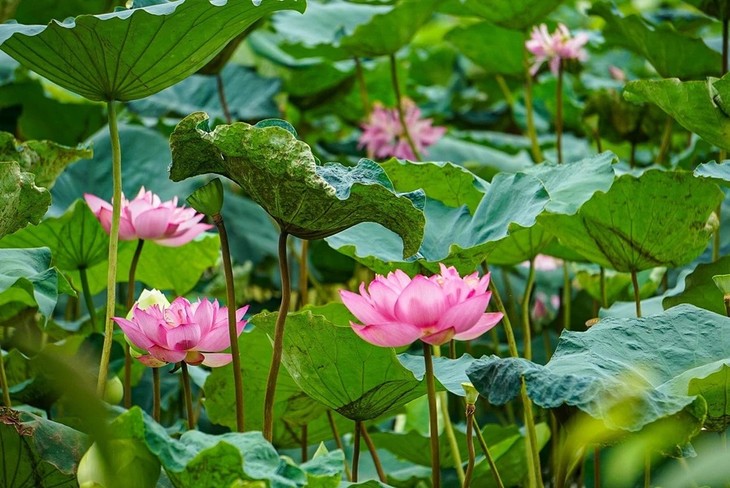 Bach Diep lotus gets its name from the hundreds of petals (Bach Diep) of all sizes that hug the yellow pistil so that it always retains its fragrance (Photo: VNA) Bach Diep lotus gets its name from the hundreds of petals (Bach Diep) of all sizes that hug the yellow pistil so that it always retains its fragrance (Photo: VNA) |
Bach Diep – which means ‘a hundred petals’ – is a rare variety of lotus found almost nowhere but in Hanoi’s West Lake. This variety is known for its elegant beauty and long-lasting fragrance. Nguyen Dinh Khuyen, Chairman of the Tay Ho district People’s Committee, said: “The West Lake area is endowed with special soil and favorable weather which cannot be found anywhere else. This is home to Bach Diep, a precious lotus species with large flowers of 100 petals with a charming fragrance. The flowers are used to make Bach Diep lotus tea, a specialty of Hanoi’s West Lake.”
The lotus is a multi-purpose plant. Every part of the plant – flowers, leaves, seeds, and roots – can be used for decoration, cuisine, medicine, or scenting tea. Lotus plants are profitable because of the many products that can be made from them.
Specialty products made from Hanoi lotuses produce profits while promoting the unique culture of Hanoi. So far, Hanoi has had 2,700 products designated as One Commune One Product (OCOP) products, including 18 products made from lotus plants.
OCOP products, like lotus silk products, Hien Xiem and Quang An lotus-scented tea, Dam Long lotus seeds, Soc Son lotus leaf tea, and Ngo Thuc lotus and young green glutinous rice, generate good profits.
Ms. Doan Thi Kim Dung, Director of the Chuong Vang Limited company, which sells Bach Diep tea products, said: “The lotus plant is closely associated with the daily life of Vietnamese people. It has economic, culinary, and medicinal value. The lotus plant is also an important motif in architecture, sculpture, painting, and poetry. Products made from lotus plants are favored by many consumers because they are environmentally friendly.”
In the face of shrinking lotus growing area, the Hanoi Department of Agriculture and Rural Development has coordinated with the Fruit and Vegetable Research Institute and the Tay Ho district People’s Committee to jointly implement a project called "Building a model of lotus cultivation associated with the development of ecotourism in line with the value chain in Tay Ho – Hanoi." The project is implemented on seven hectares of lotus ponds in Tay Ho district.
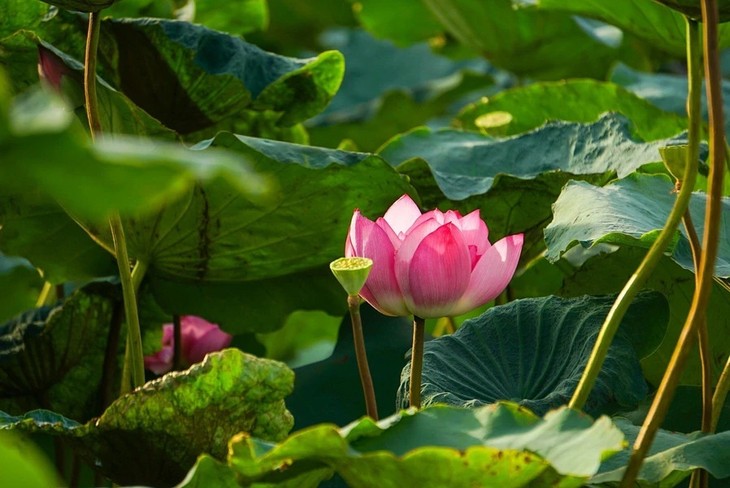 The pure and unique beauty of the West Lake lotus (Photo: VNA) The pure and unique beauty of the West Lake lotus (Photo: VNA) |
Associate Professor Dang Van Dong of the Fruit and Vegetable Research Institute of the Ministry of Agriculture and Rural Development, said: “Though Bach Diep lotus is a precious species, it has certain disadvantages. Bach Diep lotuses wilt easily, and this species doesn’t grow in the winter. The challenge is to get Bach Diep lotuses to grow in the winter and to make them last longer.”
After many years of cultivation, Bach Diep lotus plants begin to degenerate due to age and pests. Quality and productivity both start to decline. This poses the need to step in to support the genetic strength of the Bach Diep lotus.
“In the lotus pond, we look for the plants with the strongest buds and move them to a controlled environment where we can protect them from diseases and pests. In addition to preserving the Bach Diep lotus, we have also worked to create new lotus varieties that combine the qualities of Bach Diep lotus with the disease and cold resistance of other lotus varieties. This will increase profits and benefit the local people,” said Dong.
The Fruit and Vegetable Research Institute has used 80 lotus varieties from domestic and foreign sources to create more than 1,000 new varieties. Two promising varieties named SH01 and SH02 have been piloted for seeds and flowers.
Nguyen Dinh Hoa, the Department’s Deputy Director said the Agricultural Extension Centre was assigned to cooperate with the Fruit and Vegetable Research Institute to pilot the cultivation of 30 new lotus varieties in Hanoi. 20 of these varieties have been selected for their adaptability to Hanoi's soil, producing higher quality and higher yields. Thanks to technological advancements, Hanoi now boasts many new lotus varieties that have extended the lotus season from April to November.
Professor Dong stressed on uniform measures, saying “Proper management is essential. Only people dedicated to protecting the plants and the environment should be allowed to tend the lotus ponds. Lotus plants need clean water to grow, so it’s essential to filter the water and build an effective drainage system.”
Since the project "Building a model of lotus cultivation associated with the development of ecotourism in line with the value chain in Tay Ho-Hanoi" was implemented early this year, the lotuses in Dau Dong and Thuy Su have been growing well and are now ready to harvest. The model is expected to be duplicated in other lotus ponds in the area.
Nguyen Dinh Khuyen, Chairman of the Tay Ho district People’s Committee, said: “Tay Ho district intends to maintain its lotus ponds. Growing lotuses is hard work, so we’ve coordinated with the Hanoi Department of Agriculture and Rural Development and the Fruit and Vegetable Research Institute to support the local farmers with technology, seedlings, and water quality maintenance. At the same time, we’re promoting Bach Diep lotus-scented tea as an intangible cultural heritage and organizing lotus tours.”
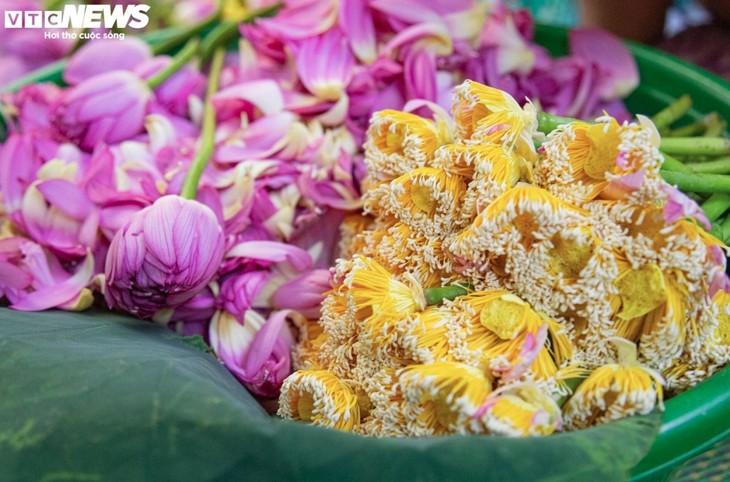 The lotus anther is an indispensable ingredient used in lotus tea. The lotus anther is an indispensable ingredient used in lotus tea. |
Bach Diep hundred-petal lotus is a precious variety of lotus grown in Hanoi’s West Lake and used to scent tea. Bach Diep lotus-scented tea has been recognized as a National Cultural Heritage.
June and July is harvest time for Bach Diep lotus farmers. Early in the morning, when the lotus flowers are freshest, the farmers start collecting them. For the longest-lasting fragrance, lotus tea must be made with Bach Diep lotus stamens. Painter Tran Hau Yen The said: “The meticulous process of the lotus tea makers gives the tea a unique flavor that goes straight to one’s soul. »
According to Hoang Anh Suong, owner of the Truong Xuan tea-house, enjoying lotus tea is an art. Only connoisseurs have a full appreciation of the tea’s sophisticated flavor. Suong said: “Hanoians love nature. There are many kinds of tea in Vietnam, but lotus tea is the most highly regarded. People call it “The King of Teas”.
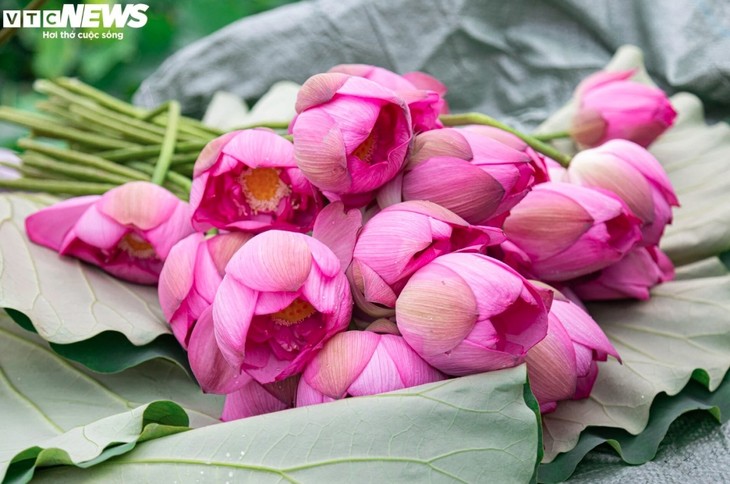 During early morning in the summer, local villagers bring lotus flowers back home which they pick from West Lake in Tay Ho district. During early morning in the summer, local villagers bring lotus flowers back home which they pick from West Lake in Tay Ho district. |
Doan Thi Kim Dung, Director of the Chuong Vang Limited company, says scenting Bach Diep lotus tea is a sophisticated process. “When it comes to lotus tea, the two most important things are the lotus and the tea. The lotus flowers used to scent the tea must be half-opened and collected early in the morning when the flowers are still covered with dew. The best tea to use is Tan Cuong Thai Nguyen tea, which has a fragrance of young green rice. There used to be two methods of scenting lotus tea.”
Dung elaborated on how to make lotus-scented tea: “The first traditional method uses 1,000 to 1,500 lotus stamens to scent 1 kilo of tea. After the tea is scented for a while, it’s dried. The process is repeated 7 times in 20 days. Tea is also scented another way. The tea was put into a lotus flower to absorb the fragrance for one night. Then the farmers collected the flowers and enjoyed the tea right beside the lotus pond.”
“These days, after the tea has been put into the flower and has absorbed the scent, we collect the flowers and dry them. That way, the tea can be kept for a longer time and is suitable for packaging as a souvenir or gift.”
The process used to make Bach Diep lotus tea is similar to that of jasmine tea or grapefruit flower tea or other types of tea.
“Don’t rinse the tea. The tea should be brewed in boiling water for about 1 minute. For thousands of years, Vietnamese tradition has refined the art of tea drinking and has reduced it to 5 key factors: First, water. Second, tea. Third, brewing. Fourth, pot. Fifth, tea partner. I think we already have good tea and now how we brew it is less important than who we enjoy it with. The important thing is that we enjoy the tea’s flavor and the meaningful moments we share with our loved ones,” said Dung.
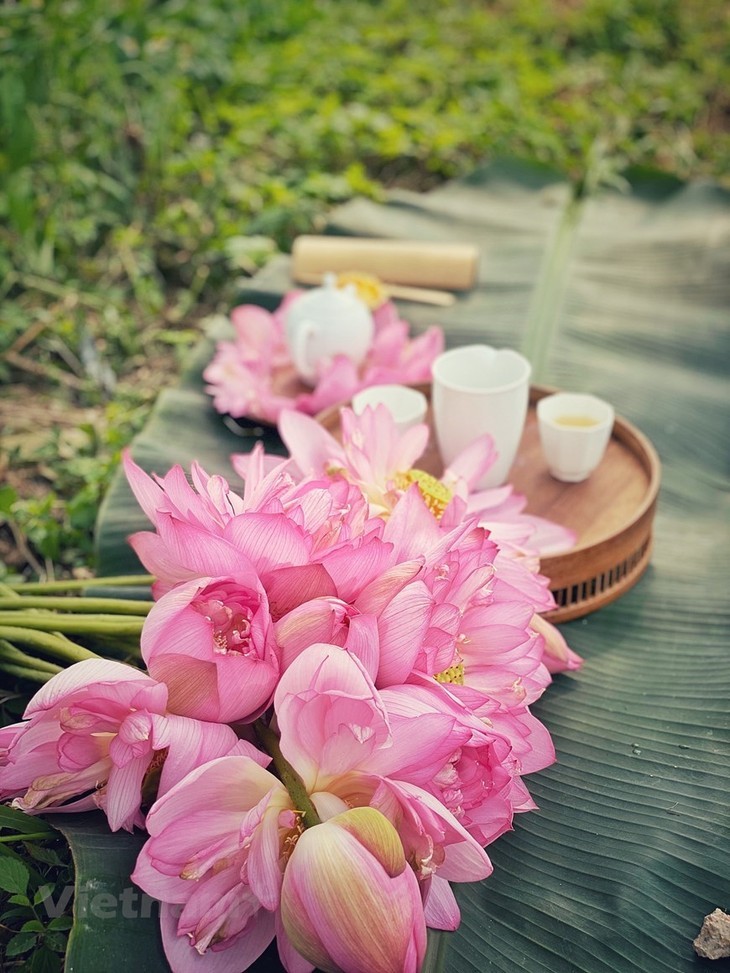 Tea is put inside a lotus flower when it has just opened. The tea packed in the flower will absorb its scent. Tasting lotus tea freshly taken from buds by stunning ‘hundred-petal’ flowers is surely an unforgettable memory for anyone. Tea is put inside a lotus flower when it has just opened. The tea packed in the flower will absorb its scent. Tasting lotus tea freshly taken from buds by stunning ‘hundred-petal’ flowers is surely an unforgettable memory for anyone. |
Hanoi now has 600 hectares of lotus, mostly in suburban districts. The city aims to expand lotus cultivation to 900 hectares by 2025 and further promotes Bach Diep lotus scented tea as the quintessential specialty of the city as well as the tea drinking culture near and far.